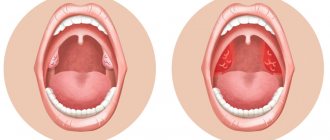- General information
- Why is a cough dangerous during pregnancy?
- Causes and symptoms
- Causes of cough typical for pregnant women
- Treatment of cough in pregnant women
- General recommendations
- Prevention
Pregnant women, due to the stress on the body and a weakened immune system, are more often than others susceptible to acute respiratory viral infections and complications after an illness.
Cough, as a concomitant symptom of colds, is dangerous because it causes contraction of the abdominal, chest and back muscles. The air flow speed during bronchospasm is about 480 km/h. This dynamics leads to uterine tone and the threat of miscarriage. If a pregnant woman is diagnosed with a cough with sputum that is difficult to clear, only a doctor can prescribe a drug for treatment. Most often these are expectorants of plant origin.
What are the dangers of colds and flu in pregnant women?
Respiratory infections pose two threats. Firstly, they may be accompanied by fever, which can lead to defects in fetal development. And secondly, influenza and ARVI during pregnancy can lead to the development of complications. During pregnancy, a number of changes occur in the immune response, as well as in the functioning of the heart and lungs, making the mother's body especially vulnerable. Therefore, colds and flu in expectant mothers are much more severe than in non-pregnant women and are often complicated by bacterial infections, including bronchitis and pneumonia.
The World Health Organization has included pregnant women at risk of developing severe and/or complicated influenza. It has been proven that pregnant women with the flu require hospitalization 4 times more often than non-pregnant women. Among patients in the third trimester, 8% require hospitalization in intensive care units [3].
Timely vaccination can prevent infection with the influenza virus during pregnancy. If infection has already occurred, the woman needs to begin treatment for ARVI or influenza during pregnancy as early as possible.
General information
Cold viruses mainly infect the mucous membranes of the nose and pharynx, as well as the upper respiratory tract. Cough that occurs when the upper respiratory tract is affected is divided into productive and unproductive.
- A productive cough occurs due to a cold (flu-like infection), bronchitis, or an allergic disease. Accompanied by the formation of a large amount of mucus discharge.
- A nonproductive cough (dry cough) occurs as a result of inflammation of the larynx, trachea, or bronchial mucosa, as well as irritation by foreign particles (dust or pollen). During a cough, mucus and sputum are not shed.
Based on its form, cough is divided into acute and chronic. An acute cough lasts less than 4 weeks and is usually caused by infection or hypothermia. Chronic cough lasts more than 4 weeks and can be caused by recurrent respiratory infections.
Is it necessary to bring down a high temperature during pregnancy and what medications can be used?
It is important to manage fever in pregnant women in a timely manner, since high temperature can negatively affect pregnancy. It is especially dangerous in the first 12 weeks, when the formation of all organs and systems occurs. Hyperthermia in pregnant women during the first trimester doubles the risk of developing neural tube defects (future brain and spinal cord defects) and may also be associated with other birth defects and adverse outcomes in the baby [1].
It is not known for certain which temperature exceeding the greatest danger. Thus, data from a cohort study involving more than 77 thousand women showed that the incidence of malformations was approximately the same among those who reported a fever below 39 and above 39 degrees in the first trimester [1].
The drug of choice for reducing fever is paracetamol, which is approved for use throughout pregnancy [2]. In addition, ibuprofen is used as an antipyretic and analgesic in the first and second trimesters. Multivitamins containing folic acid can reduce the risk of developmental defects due to hyperthermia [1].
How to reduce a sore throat? What antiseptics can I take?
During pregnancy, it is allowed to use a number of antiseptics for sore throats, so it is not necessary to endure sore throat and other unpleasant symptoms during this period. Medications that expectant mothers can take include:
- ambazon, which has an antimicrobial effect against streptococci, daily dose 4–5 tablets 0.04–0.05 g;
- the combination of lysozyme + pyridoxine exhibits an antiseptic effect against gram-positive and gram-negative bacteria, fungi and viruses. Vitamin B6 in its composition has a protective effect on the oral mucosa. Prescribe 2 tablets 3-4 times a day.
In addition, warm drinks, which are indicated in unlimited but reasonable quantities, help reduce sore throat.
General recommendations
- The air humidity in the room should be 65-70%. This level of humidity is comfortable for the body, prevents the mucous membrane from drying out, and reduces the rate of development of pathogens. Wet cleaning reduces the risk of contact with allergens (pollen, dust, pet hair).
- The room must be ventilated regularly, at least 2 times a day. Fresh air reduces the concentration of the virus in the air. It is recommended to maintain the room temperature at 22 degrees.
- It is necessary to drink enough fluid to liquefy the mucus naturally.
- Bed rest, especially in the first 3-4 days after the first symptoms appear.
Can pregnant women take any expectorant medications?
Therapists and obstetricians-gynecologists recommend that pregnant women refrain from taking expectorant medications if possible. The vast majority of drugs in this group are prohibited for use during pregnancy, including herbal remedies, which are often considered “safe” by consumers. In fact, plantain syrup, preparations based on thyme and thyme extract, and other popular herbal remedies are contraindicated for pregnant women.
At the same time, the drug ambroxol is still approved for use by pregnant women in the second and third trimesters with the label “with caution.” The same applies to bromhexine - it is prescribed, but only after a careful assessment of the benefit/risk ratio, and only the attending physician can carry it out. Therefore, primary care providers who advise pregnant women with requests for expectorant medications should limit themselves to insistent advice to consult a doctor. And the only recommendation that should be given in such situations is to drink warm drinks and sufficiently humidify the air in the room.
Prevention
- It is not recommended to visit crowded places, especially during seasonal flu epidemics.
- Contact with sick people should be limited.
- On a regular basis, it is necessary to use products to moisturize the nasal mucosa.
- After visiting public places, it is important to thoroughly clean your hands with antibacterial agents.
- It is necessary to wear a gauze bandage when visiting medical institutions and public institutions.
- You should only use personal household appliances and hygiene products to prevent the transmission of germs through household means.
What can a pregnant woman take for a debilitating dry cough?
Antitussive drugs, like mucolytics, are prohibited from taking during pregnancy at all or are allowed under the supervision of a doctor after assessing the risks and benefits. Thus, the popular centrally acting antitussive drug butamirate can be taken only in the second and third trimesters and only after consultation with a doctor. The peripheral drug prenoxdiazine is also used with caution during pregnancy. Thus, when counseling a pregnant woman with a dry cough, she should be advised to immediately visit a doctor.
Is it possible to be treated during pregnancy with infusions, decoctions of medicinal herbs or herbal teas?
Despite their natural origin, not all preparations based on medicinal plants, including herbal teas, are safe during pregnancy. Herbs may contain active substances that negatively affect the development of the fetus or increase the tone of the uterus. Herbs can cause miscarriage or stimulate premature labor. Medicinal plants that are unsafe during pregnancy include [4, 5]:
- chamomile - can promote uterine contractions;
- licorice root - may increase the risk of premature birth;
- laxative herbal teas based on senna and other plants - active intestinal peristalsis can stimulate the contractile activity of the uterus;
- common twig - stimulates the production of estrogen, may increase the risk of miscarriage;
- echinacea - activates the synthesis of oxytocin; aloe vera - stimulates the contractile activity of the uterus;
- calendula - has an abortifacient effect and many others.
However, there are also medicinal plants that have been proven safe during pregnancy. Among them [6]:
- raspberry leaves;
- peppermint leaves;
- plantain oval seed shell;
- garlic.
Since the list of medicinal plants that are unsafe during pregnancy is quite large, it is still better to take herbal medicines during this period after consulting with your doctor.
Cough with phlegm during pregnancy
With a wet cough, sputum is released: it is distinguished by volume, consistency, thickness and color. Cough with sputum is more typical for diseases of the lower respiratory tract (bronchitis, pneumonia). With a productive cough, sputum is actively expectorated in large quantities. An unproductive cough is more often observed in the first days of infectious diseases in the form of a small amount of viscous discharge, or is of allergic origin.
Are any antiviral drugs allowed during pregnancy?
The treatment regimen for influenza in pregnant women includes antiviral drugs from the group of neuraminidase inhibitors. They are active against influenza A and B viruses, and their effectiveness has been demonstrated in numerous clinical studies [7, 8]. Antiviral drugs of this group disrupt the ability of viral particles to penetrate into cells, which leads to localization of infection in the body, alleviation of the condition and reduction of the likelihood of complications during pregnancy [7]. According to international and Russian recommendations, neuraminidase inhibitors are the drugs of choice for influenza, including during pregnancy [8]. Their effectiveness is highest when taken within the first 48 hours after the onset of the disease, so when the first flu symptoms appear, it is very important to consult a doctor and begin treatment. Let us remember that neuraminidase inhibitors are prescription drugs ( also in this case it is necessary to make sure that the patient has the flu and not ARVI in pregnant women - editor's note.
).
Why is a cough dangerous during pregnancy?
- 1st trimester. The fetus's nervous and vascular systems are forming; the natural barrier in the form of the placenta has not yet formed, so damage to intrauterine infection is fraught with fetal pathologies.
- 2nd trimester. The placenta is forming, and acute respiratory viral infections can slow down this process. Cough causes severe stress on the pelvic organs, which provokes placental abruption. Characteristic signs are nagging pain in the lower abdomen, bleeding. The supply of oxygen and nutrients stops, this leads to hypoxia and termination of pregnancy. In this case, short-term hypoxia (5-10 seconds) does not cause harm.
- 3rd trimester. A productive cough can lead to rupture of the amniotic sac, premature birth, and bleeding. Cough accompanied by high fever provokes aging of the placenta.
In addition, coughing causes stress for the expectant mother. A constant feeling of discomfort and fears for the child’s health contribute to the production of large amounts of cortisol. The stress hormone, in turn, activates the work of the heart and provokes vasospasm. These factors, when exposed to the body for a long time, cause fetal hypoxia and premature birth.
As for complications in a child, weak immunity, nervousness, and low weight are possible against the background of a cold the mother suffered.
According to medical observations, viral diseases are most common during gestation - up to 85% of cases. Bacterial diseases account for up to 15% of cases. Frequent pathogens are adenoviruses, streptococci, coronaviruses, enteroviruses, and rhinoviruses.
How to boost immunity during pregnancy?
The following help increase the body's defense against respiratory infections during pregnancy:
- a balanced diet that compensates for a woman’s needs for nutrients, vitamins, and microelements;
- healthy sleep;
- laughter – helps to activate the immune response [9];
- taking probiotics, which normalize the composition of the intestinal flora, which helps reduce the risk of respiratory infections and reduce the severity of cold symptoms [10];
- taking multivitamin complexes containing vitamin D, which helps relieve cold symptoms and reduce the incidence of infection [11].
In addition, to increase the immune response, the doctor can prescribe interferon alpha-2b drugs - intranasal or rectal (there may be restrictions on the duration of pregnancy, for example, some of them are prescribed only after 14 weeks - editor's note).
Cough is a symptom that is familiar to everyone
It accompanies both the common cold and serious diseases, including diseases of the lungs, heart and even stomach.
Most people prefer to treat their cough on their own. But not everyone knows that it is not the cough itself that needs to be treated, but the disease that led to its occurrence. A little anatomy A person takes about 20,000 breaths a day. At the same time, approximately 8000 liters of air enter the respiratory tract. The respiratory tract is divided into upper and lower: upper respiratory tract
- this is the nasal cavity
- pharynx (nasal, oral and laryngeal parts)
- larynx
lower respiratory tract
- these are the trachea and bronchi
Normally, about 2 liters of mucus are formed in the respiratory tract per day, which contributes to the natural cleansing of the respiratory tract. The mucous membrane of the bronchi is designed in such a way that the mucus, with the help of special cilia, rises up into the pharynx and is then swallowed. And from the upper respiratory tract (nose and nasopharynx), mucus freely flows down and is also swallowed.
If there is a violation of the mucous membrane (for example, smokers have no cilia in the bronchial mucosa) or any factors cause thickening of the mucus, then it cannot be excreted freely and stagnates. All this leads to irritation of the so-called. cough receptors (special cells that are involved in the cough reflex). It turns out that cough receptors are present not only in the respiratory tract, but even in the heart and stomach. Those. diseases not only of the respiratory tract will be accompanied by a cough.
Thus, a cough that occurs as a result of severe arrhythmia helps the patient not to lose consciousness and even helps restore the normal rhythm of heart contractions. What is a cough like? The cough can be constant and short, barking and silent... Coughs are also divided into wet (doctors call it “productive”) and dry (“unproductive”).
A wet cough produces sputum. It can be liquid or thick, mucous (transparent) or purulent (yellow, green). If the sputum is red or brown, contains streaks or blood clots, then this symptom is called hemoptysis. The amount and nature of sputum gives the doctor information about the cause of the cough. For example, thick green sputum indicates severe inflammation that should be treated with antibiotics.
And depending on whether sputum comes out at all, it will depend on what medications need to be prescribed. For example, if you have hemoptysis, you should not take expectorants, because they may increase the amount of blood in the sputum. And with a dry cough, the use of expectorants can intensify the cough, even to the point of suffocation. A cough that takes up to 3 weeks to cure is an “acute” cough; it most often accompanies ARVI. If the cough persists for more than 3 weeks, it is called “chronic.” Chronic cough is a sign of a serious illness.
Different diseases - different coughs.
Diseases of the upper respiratory tract The most common cause of cough is the familiar acute respiratory disease (ARI). The cough is usually dry, accompanied by pain and sore throat. A runny nose during acute respiratory infections can also cause coughing due to mucus draining down the back wall of the throat.
Bronchial asthma In approximately 10% of cases, the only manifestation of bronchial asthma is a cough.
With an exacerbation of bronchial asthma, a narrowing of the lumen of the bronchi occurs, which complicates the passage of air mainly during exhalation and leads to coughing, wheezing or attacks of suffocation. A typical cough is that it occurs at night and in the early morning hours.
Inflammatory diseases of the bronchi and lungs: bronchitis and pneumonia Inflammation and the presence of mucus in the respiratory tract leads to irritation of cough receptors during bronchitis and pneumonia. With these diseases, the cough is very rarely dry and is always accompanied by an increase in body temperature.
Smoker's cough Smokers are characterized by a cough in the morning with the discharge of thick sputum and frequent coughing throughout the day. If smoking has not led to the development of a chronic disease, then it is enough to give up the bad habit for the cough to disappear on its own.
Gastroesophageal reflux disease This disease causes the valve that separates the esophagus from the stomach to relax. Reflux is the reflux of food from the stomach back into the esophagus. Heavy eating, bending the body, and even singing can provoke the contents of the stomach to enter the esophagus. The acid contained in the gastric juice irritates the esophagus and can lead not only to heartburn, but also to cough. Sometimes a cough is the only sign that something is wrong with your stomach.
Cardiac cough Most heart diseases result in the heart not being able to pump the required amount of blood. Blood “stagnates” in organs, incl. and in the lungs. This leads to irritation of the cough receptors. A dry cough occurs, worsening in a horizontal position. The cough may be accompanied by palpitations, a feeling of shortness of breath, and shortness of breath. There is no treatment for such a cough; it will disappear on its own if the signs of heart failure are eliminated.
Cough due to medications Taking a number of medications can lead to side effects such as coughing. The reasons for this effect of drugs have not yet been sufficiently studied. It helps to recognize that medication has led to the development of a cough if there was no cough before the medication was prescribed. The cough bothers you mainly in the daytime, it is dry, and more often it is a small but debilitating cough. 3-7 days after discontinuation of the drug, the cough disappears. Cough with tumors Some lung tumors for a long time can manifest themselves only as a cough: dry or with the release of a small amount of light sputum. No changes are detected on radiographs of the lungs. Only visiting a doctor and carrying out special research methods helps make a diagnosis at an early stage.
Cough with whooping cough Whooping cough is an infectious disease that occurs with a prolonged paroxysmal spasmodic cough. In the first 2 weeks, the cough is similar to the cough of a common cold and may be accompanied by a runny nose and a slight increase in body temperature. Starting from the third week, a period of debilitating cough begins. The cough comes in attacks that are repeated from 2 to 15 times in a row. Such a cough must be treated, because... it leads to serious complications. Complications that a cough can lead to. Frequent persistent cough, especially in the form of prolonged attacks, leads to an increase in intrathoracic pressure and can contribute to the development of: - pulmonary emphysema - cardiac complications (arrhythmias, increased ischemia, development of cor pulmonale) - hemorrhage in the sclera of the eyes - dizziness - fainting - deterioration of cerebral blood circulation (especially if there have been previous strokes) - lung rupture
In addition, cough can lead to headache, vomiting, sleep disturbances, and urinary and fecal incontinence in an elderly, debilitated patient. Chronic cough can lead to the formation or enlargement of existing hernias (diaphragmatic, inguinal, scrotal, etc.). Chronic cough can cause depression, which complicates the patient's relationships with others, which ultimately significantly worsens the quality of life. What research needs to be done.
In order to avoid serious complications and make a timely diagnosis, you must consult a doctor.
Depending on the characteristics of the cough, its duration, and based on the results of the examination, the doctor will prescribe an examination. As a rule, this is a clinical blood test, fluorography and a study of external respiratory function. If the results of these studies do not help determine the diagnosis or even during the examination one can suspect that they will not be enough, the doctor prescribes more complex studies (for example, bronchoscopy, computed tomography, lung scintigraphy) and consultations with specialists. You can hardly find a person who has never coughed. And, of course, there is no need to consult a doctor every time at the first sign of a slight sore throat or slight cough. These disorders are transient. However, it should be remembered that only a doctor can reliably recognize the cause of cough and prescribe the necessary treatment.
Symptoms that should alert you and prompt immediate medical attention: - hemoptysis (sputum is uniformly red or with red/brown streaks) - increased body temperature for more than 3 days - choking or shortness of breath - cough for more than 3 weeks - chest pain - nausea and vomit"
Is it possible for a pregnant woman to apply mustard plasters and pepper plaster?
Despite the fact that both mustard plasters and pepper plaster act externally and do not affect the development of the fetus, they are potentially dangerous for pregnancy. Heat treatments can increase uterine contractility, which is associated with an increased risk of miscarriage or premature birth. In addition, increased microcirculation, which occurs under the influence of mustard plasters or pepper patches, can change uteroplacental blood flow, which is also undesirable. The greatest danger is posed by thermal procedures in the first and last trimester of pregnancy - in the first they increase the risk of miscarriage, in the last - premature birth.







